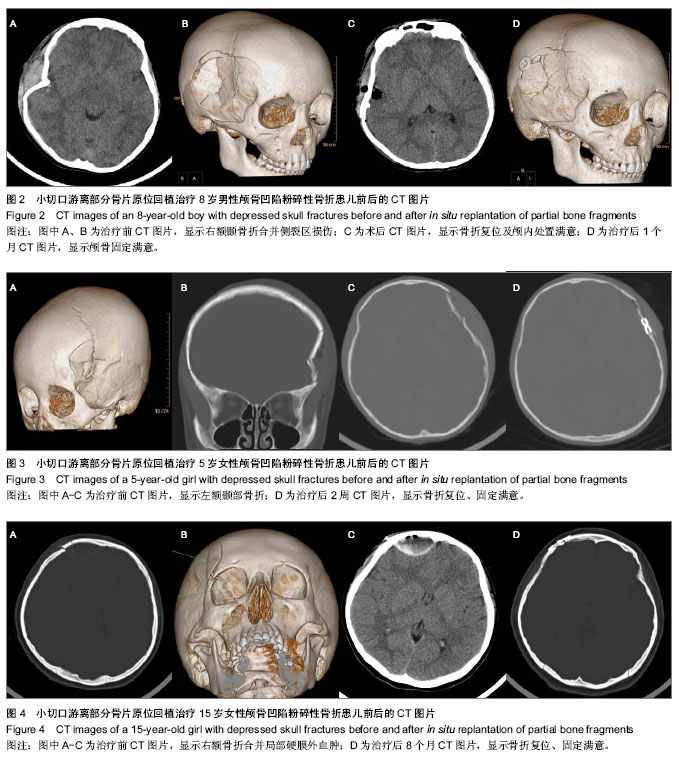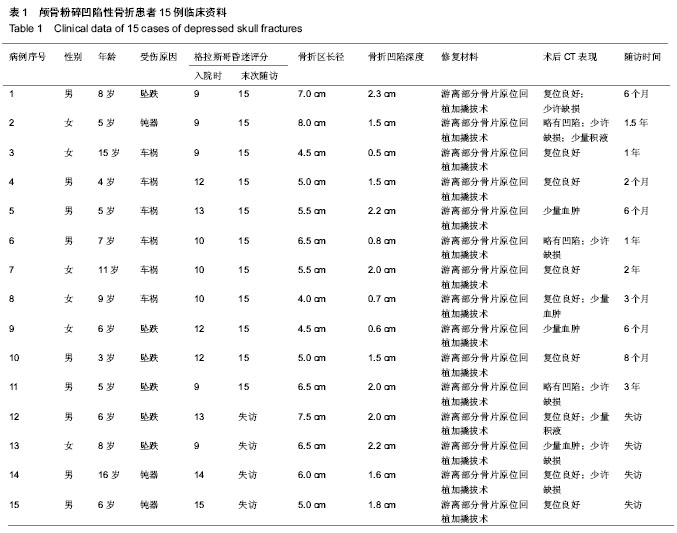| [1] 杨金福,廖达光,王知非,等.带蒂骨瓣开颅治疗儿童颅骨凹陷粉碎性骨折[J].基层医学论坛, 2006,10(7):598-599.
[2] 燕武,外力•艾比布力.小切口撬拨整复术治疗小儿颅骨凹陷性骨折[J].新疆医科大学学报,2012,35(5):653-655.
[3] 张旭海.带蒂骨瓣开颅颅骨成形治疗小儿开放性凹陷性粉碎性颅骨骨折体会[J].山西医药杂志,2010,39(15):747-748.
[4] 白奕斌,黄永华.小儿颅骨凹陷性骨折的手术治疗[J].临床和实验医学杂志,2006,5(7):982.
[5] 吴明灿,陈世洁,闵杰,等.自体颅骨瓣帽状腱膜下埋藏与复位治疗儿童重型颅脑损伤[J]. 广东医学,2010,31(9):1161-1162.
[6] 冯黎.小切口单骨孔微创整复与传统手术治疗婴幼儿颅骨凹陷性骨折比较研究[J].中外健康文摘,2012,9(4):233-235.
[7] 陈其民,顾硕,顾松,等.内窥镜辅助下微创手术整复婴幼儿颅骨凹陷性骨折[J].中国神经精神疾病杂志,2007,33(10): 626-627.
[8] 罗永庠,邓元央.颅骨固定体治疗颅骨凹陷性粉碎性骨折疗效观察(附30例报告) [J].中国实用医药,2013,8(8):134-135.
[9] 王军,熊双宜.应用钛板连接片治疗凹陷性粉碎性颅骨骨折的体会[J].中国现代神经疾病杂志,2007,7(1):87.
[10] 张晓东,肖焕杰.应用耳脑胶治疗凹陷性粉碎性颅骨骨折的体会[J].黑龙江医学,2005, 29(3):219.
[11] 刘生华,康伟,徐培,齐再利,等.钛网一次成形一期整复开放性颅骨粉碎性凹陷性骨折[J].中国医疗前沿,2009,4 (6):62.
[12] 朴松鹤,齐宇,孙志博.微型钛板在颅骨凹陷粉碎性骨折中的应用[J].中国微侵袭神经外科杂志,2010,15(5):236.
[13] 庄强,徐娉,张亚波.医用胶粘合加丝线固定一期整复开放性颅骨粉碎性骨折疗效观察[J]. 山东医药,2009,49(6):92-93.
[14] 苏同刚,袁邦清,黄绍宽.骨水泥在颅骨凹陷粉碎性骨折早期手术中的应用(附29例报告) [J].中国临床神经外科杂志,2012,17(7): 421-422.
[15] 张立杰.颅骨修补材料的临床应用及研究现状[J].中国组织工程研究与临床康复, 2008,12(10):1939-1942.
[16] Hughes CW,Revington PJ.The proximal tibia donor site in cleft alveolar bone grafting:Experience of 75 consecutive cases.J Craniomaxillofac Surg. 2002;30(1):12-16.
[17] 周志宇,黄冠斌,李光,等.钛网I期修补在开放性、粉碎性、凹陷性颅骨骨折术中的应用[J]. 中国临床神经外科杂志,2011,16(2): 115-116.
[18] 阮清锋,梁树恒,张天隆.颅骨固定钉联合医用胶治疗颅骨凹陷性粉碎性骨折[J].右江医学,2007,35(4):416-417.
[19] Li X,Qian C,Yang S,et al.Cranial reconstruction with titanium clamps in frontal comminuted depressed skull fractures.J Craniofac Surg.2013;24(1):247-249.
[20] Yeo MS, Sundar G, Lim TC.The kidney dish as a template for titanium mesh contouring in supraorbital rim fractures: a simple and effective method.J Oral Maxillofac Surg. 2011; 69(6):e161-164.
[21] Marbacher S, Andres RH, Fathi AR,et al.Primary reconstruction of open depressed skull fractures with titanium mesh.J Craniofac Surg.2008;19(2):490-495.
[22] Wörner B,Lange M,Herzog A,et al.A new method for surgical repair of impression fractures of the cranial vault and frontal sinus with rivet-like titanium clamps.Neurosurg Rev.2001; 24(2-3):83-87.
[23] Ebel H,Schillinger G,Walter C,et al.Titanium clamps for refixation of bone fragments in the repair of depressed skull fractures: technical note.Minim Invasive Neurosurg. 2000; 43(4):212-214.
[24] 张旭海.游离骨瓣成形术在儿童凹陷骨折治疗中的临床研究[J].河北医药,2010,32(12):1557-1558.
[25] 王忠诚.神经外科学[M].武汉:湖北科学技术出版社,1998:314.
[26] 陈静,卢明,彭立辉,等.重型特重型颅脑损伤并侧裂区血管损伤60例诊治分析[J].临床外科杂志,2010,18(7):464-465.
[27] 吴祖超,邓冬英.弧形小切口、钻孔加小骨槽治疗颅骨凹陷性骨折21例分析[J].福建医药杂志,2005,27(4):87-88. |


.jpg)